How ABS and hyper-personalization can solve the dilemma.
The hotel industry is slowly moving into commodities; this is nothing new and the topic has been keeping hoteliers busy for the last decade. This is why many hotels (branded and non-branded) played and are still playing the card of “selling experiences”.
However, are they?
“You booked a room with some features (like mountain view, quiet location, large king bed…) and when you enter the room unfortunately the one allocated to you does not match what you booked. Does this sound familiar? You now have two choices: go to reception and complain in the hope that they can move you somewhere else or become a silent complainer leaving a bad review once you left and never come back again. The starting point here is: are we clear about what we are selling?”
This is how the CEO and founder or GauVendi, Markus Mueller, opened his speech at the Global Revenue Forum in Milan back in January this year and this is an overview of his session.
If we wish to focus on experience, a much more guest-centric approach is needed: why are our guests travelling? With whom? For how long? The way to personalization is long but it needs to be started somewhere. It’s all about giving the chance to guests to book what really matters to them rather than choosing from a fixed room-type selling model where many of the features might be irrelevant to them for the purpose of their trip.
What does really impact the room experience in the first place, after what we see, smell etc. (5 senses) is its functionality which is often underestimated, and which often marks the gap between “expectation” and “experience”.
But there are two additional elements which heavily impact room experience:
- movement through time and space, in other words how the room has been designed and what is the style (traditional, modern, design…) and
- individual emotions.
The theory is as follows: we all discuss our products and their design, our new F&B concept, our innovative lobby concept, and our modern room concept.
However, in reality, when it comes down to selling, we approach our Sales and Marketing director and our Revenue Manager and ask to fill the room at the highest rate possible, as Markus experienced during his long career in the hospitality industry.
To do so, we first start bucketing inventory into room categories like Standard, De Luxe, Superior, Executive, Suites mainly based on the main features a specific room type offers.
Then the next step comes: how do we sell it? Think about the various channels and the limitations of each of them.
For example: in our own site (brand.com) we sell everything to everyone; via phone and/or email replies to requests will depend on the staff and their product knowledge; distributors like OTA’s will force you to standardize room types to make sure they are comparable with your competitors; with our contracted rates we choose our base room category, and we start negotiating and the same applies for groups.
In any scenario we end selling room categories, in many cases the lowest ones focusing on price where rooms become commoditized.
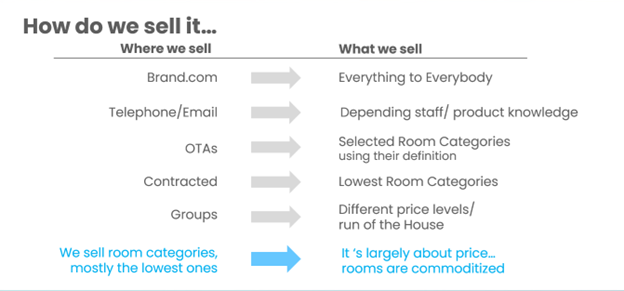
However, how did we end up selling commodities when the hotel industry is different from airlines because of selling experiences?
Let’s have a look at some background… While other industries (music, movies, and clothing for example) did get familiar with personalization it looks like the hotel industry is still stuck in standardization.
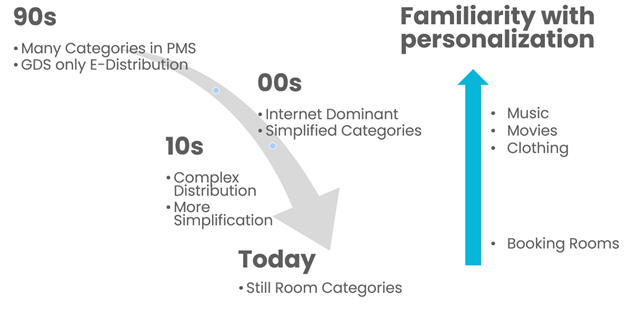
The truth is that today room categories are a big compromise… think about the lack of transparency during the booking process, the poor differentiation for Sales and Distribution (linked to a low negotiation power) and about idle room assets when talking about pricing.
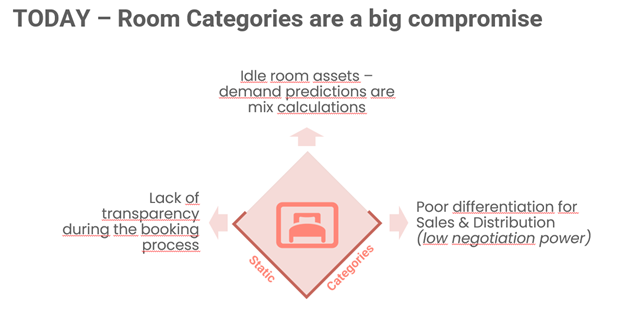
If we want to drive personalization, we must transform the way we manage our core assets: our rooms! And to do so we need to re-structure our inventory data which is the base of any new sales strategy.
To move away from room categories Markus introduced us to the “poliydynamic” and “feature-based” inventory concept which is the basis for hyper-personalization.
Room categories can still be sold, however much more data will be collected (high/low floor, Bath tube / shower, garden / street / internal view) to sell features-based product and combined products.
The key and revolutionary concept is that you can sell the same room with different names based on features and attributes and based on who is booking it.
Let’s make an example: your room number 501 in your PMS is a Junior Suite and is sold in all channels as such. However, the same room can be sold with different names at different price points for different persona’s…
For example, as a Business Executive room type for the corporate travelers who are not allowed to book suites or as a personalized room type for individual travelers focusing on its features (lovely corner suite, high floor, quietly located) or as a family room type for families who need connected rooms. In essence the same room can be priced differently depending on how and to whom it will be sold.
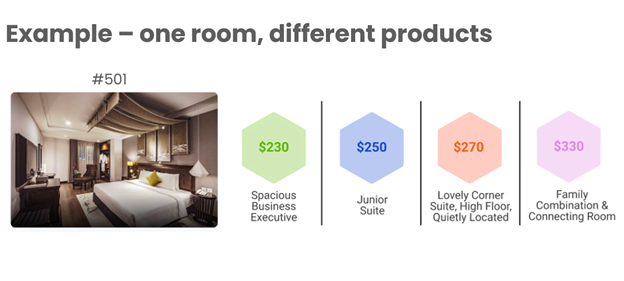
The key question here is: how to make it possible to stand out with hyper-personalization?
Through 2 factors:
- Labelling tactics (visual and textual stimuli)
- ABS or Attribute-based selling/shopping
Let’s start with the first one… What is “labelling tactic”?
It means adding different labels to each of the room types like “Lowest Price”, “Most Popular”, “Most Picked” etc.
Here an example with beneath the name of the room/product (not the room category):
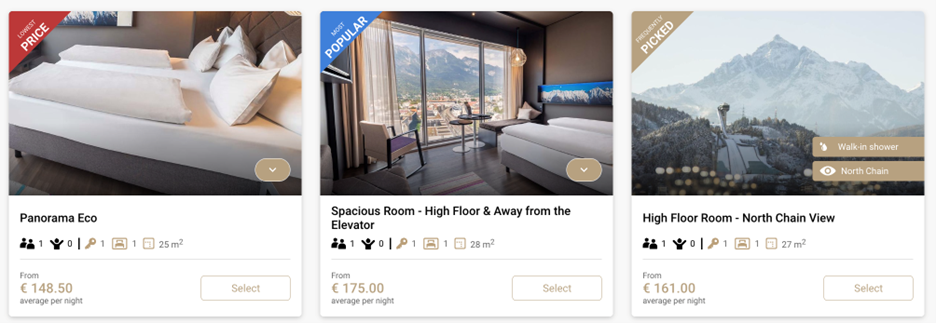
Results in Q4 2022 were astonishing:
- Every third guest booked “Most Popular” or “Frequently Booked” labelled room/product.
- 18% AVR increase over Lowest Priced rooms/products.
- Significant product sales shift towards higher value rooms/products.
The results of labelling tactics shifted the traditional revenue management discussions on pricing as such to a more price gaps analysis for example between the Lowest Price and the Most Popular labelled rooms moving the focus to willingness to pay and price sensitivity.
What about the second factor, ABS or Attribute Based Selling/Shopping, an acronym launched by airlines when they started charging luggage fee when booking a flight?
The hospitality industry has been talking about ABS for years facing the following challenge: how can we unbundle the core room product and monetize on each of the features and attributes?
Watch out… It’s not about ancillary upselling or post booking upsell like late check-out, something very traditional which has been out for years in our hotels. It’s something different… it’s about selling of individual room features and attributes like high floor, walk-in shower, or specific views at the time of booking!
How to do it? Keeping in mind that selling experiences is what makes a hotel different from a plane, a “configuration bar” has been added to the booking page, allowing you to select preferences for your room. The rooms displayed will be ranked based on the % match of the selected preferences.
After testing it, the results were astonishing: 25% of guests chose their preferences; AVR increased by 21% over Lowest Price, ancillary sales increased by 30% and a clear channel shift towards direct was visible.
Features and attributes are pivotal in the way we guide the booking processes. Think about a traditional way of promoting our rooms when in need of some extra volume like a % off for members.
With ABS the way of promoting will be through the choice of features and attributes, which does not mean that the price point is different from a % off for a traditional promotion, however message is completely different, and personalization plays a big role, offering a great opportunity to differentiate yourself from the competitors.
In addition, selling by features and attributes will deliver a new insight and set of data you can capitalize on, aiming to constantly improve experience. A better understanding of features and attributes (we might discover for example that low floor is very much in demand as high floor) will lead to different pricing decisions of features and attributes (price will change according to demand), to better CAPEX decisions based on guests’ preferences expressed during the booking process and to a much more personalized marketing communication based on which type of guest prefers which feature.
There are though some considerations to be made:
- You cannot apply ABS if you do not change the way you manage your inventory.
- You must move from traditional “booking engine” to “sales engine” avoiding the paradox of choice with relevant products and smart filters.
- You will need automated length of stay management.
- You will need to apply dynamic inventory management.
So, here some final takeaways from Mark’s session:
- Look at your room inventory with fresh eyes.
- Identify the room features attracting your core target audience.
- Regroup categories if necessary.
- Sharpen sales and reservations pitches.
- Review your tech-stack.
Because it was a great and inspiring session, I took the liberty to contact Markus directly and ask some specific questions based on his speech.
The first question is about the future of personalization and onward distribution. In other words, what are the technological implications of an adoption of ABS for OTA’s for example?
The future of personalization and onward distribution is poised for transformation. While sunken costs and legacy incumbents have historically hindered innovation, we are witnessing a shift.
Open APIs are becoming the norm, enabling realistic interfaces between systems. It’s only a matter of time before critical mass is reached, leading to OTAs and other platforms adopting new distribution logics that allow for greater personalization.
Translating layers, such as GauVendi, will play a crucial role, transforming feature-based inventory into meaningful and relevant stay products right from the time of booking.
What about PMS… how would you manage the possibility of selling the same room with different names based on features and attributes?
We serve as a translating layer, converting feature-based inventory for PMS and translating it back to the connected unit. Unlike most PMS, we have the capability to do this effectively.
Managing fulfillment becomes critical when selling attribute-based rooms to avoid operational challenges. By allocating rooms based on preferences and dynamically re-assigning them, we maximize revenue opportunities for the property.
Our solution takes care of these complexities, ensuring a seamless and efficient process for room allocation and revenue optimization.
Outside the technology landscape, what is the biggest challenge you are facing when approaching hotels to sell ABS?
One of the biggest challenges we face when approaching hotels to sell ABS is overcoming myths and misconceptions that have arisen from traditional inventory management practices.
Shifting to a more granular level of inventory management is relatively new and requires change management and education.
For example, a common misconception is that blocking a room during sales limits flexibility in room assignments because it is believed that guests require very specific room attributes, resulting in only one available option.
However, the reality is that guests often have broader preferences that allow for more flexibility in room assignments. Blocking a room at the time of booking actually enables better demand management by addressing arrival and departure patterns that can cause issues. It’s important to note that a more granular inventory approach doesn’t mean constantly selling hyper-personalized options.
Instead, it offers the ability to sell what makes sense for both the hotel and the customer, providing options while maximizing efficiency.
